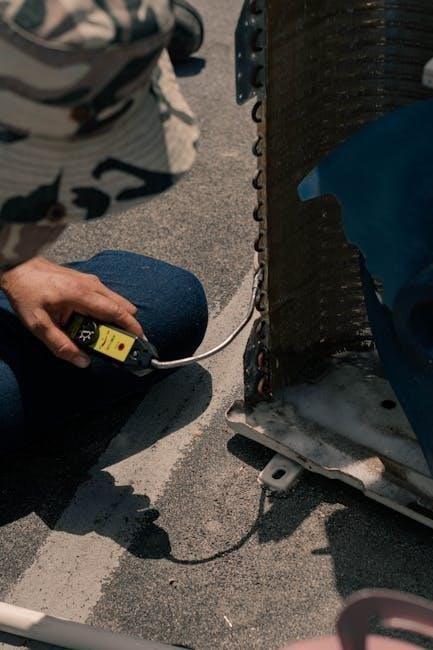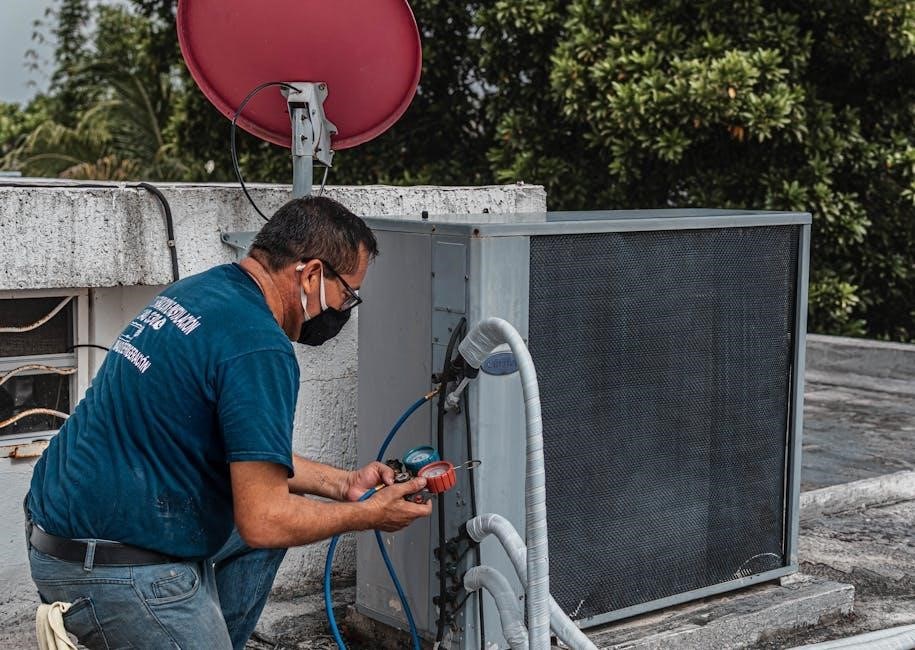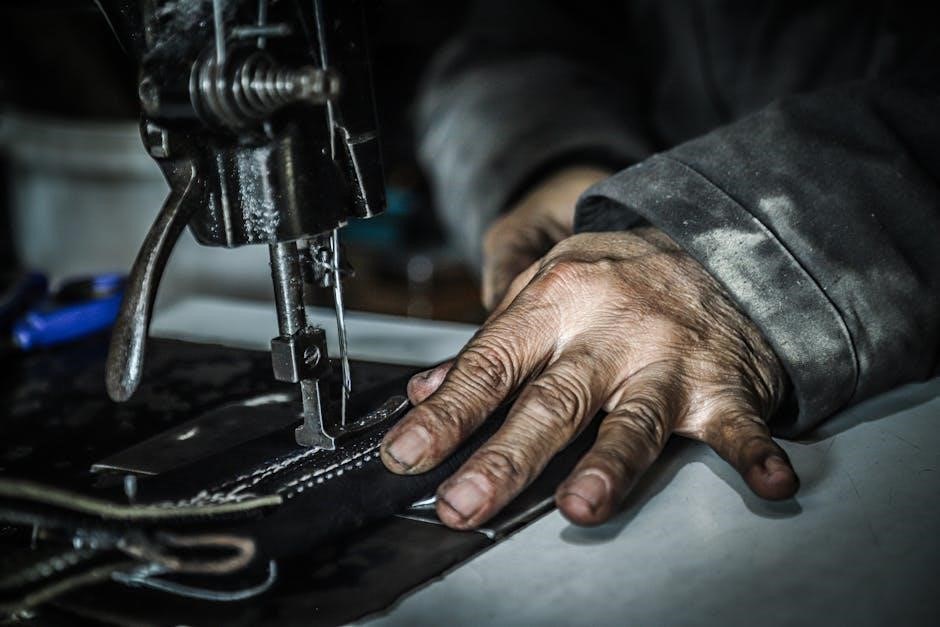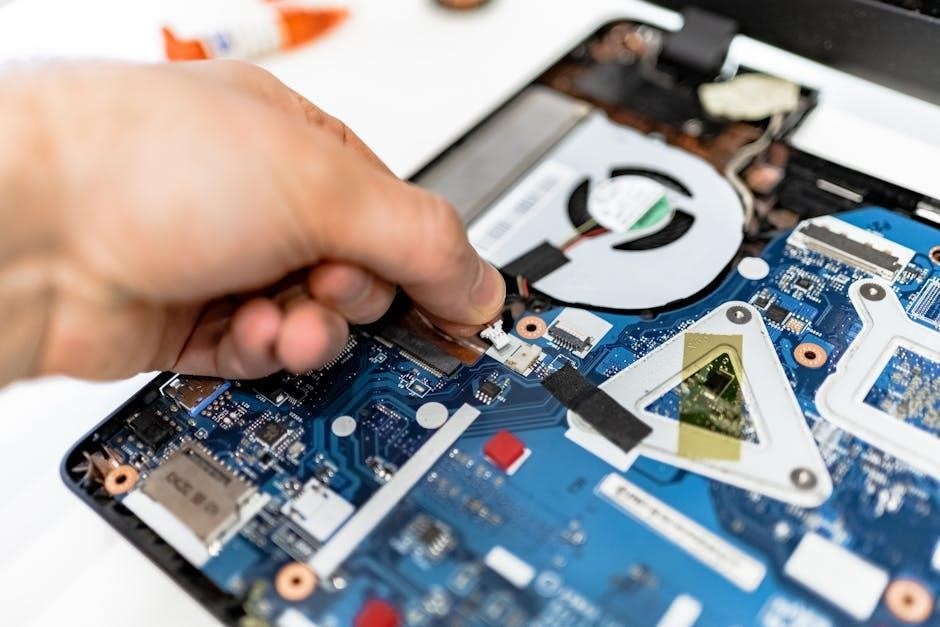Tennant T7 Troubleshooting Manual: A Comprehensive Guide
This comprehensive guide provides essential information for troubleshooting the Tennant T7 floor scrubber. It covers electrical and mechanical systems, offering solutions for common issues. The manual aims to help users quickly identify and resolve problems, ensuring optimal performance and longevity of the machine.
Understanding the Tennant T7 Scrubber
The Tennant T7 is a ride-on floor scrubber designed for ease of use and maintenance, suitable for cleaning tight spaces. Its compact design and high maneuverability make it ideal for narrow aisles; The T7 features easily accessible and cleanable hygienic solution and recovery tanks, simplifying maintenance tasks. A built-in brush wear indicator removes guesswork from brush maintenance, ensuring optimal cleaning performance.
This scrubber incorporates advanced technologies like the ec-H2O NanoClean, enhancing cleaning effectiveness. The T7AMR (Autonomous Mobile Robot) version includes robotic components such as LIDARs and 3D cameras for autonomous operation. Understanding the T7’s components and their functions is crucial for effective troubleshooting and maintenance.
The T7’s design prioritizes safety and efficiency. Regular maintenance, as outlined in the service information manual, ensures the machine operates at its best. Report any damage or faulty operation immediately to prevent further issues. Always adhere to safety precautions, especially when working with batteries or electrical components.
Identifying Your Specific T7 Model
Accurately identifying your specific Tennant T7 model is crucial for accessing the correct service information and parts. The model number and serial number are typically found on a data label affixed to the machine. This label provides essential details for ordering parts and troubleshooting issues. Refer to the Tennant parts manual for accurate component identification.
The T7 series may include variations such as the standard T7, T7AMR (Autonomous Mobile Robot), and models with different brush configurations or optional features like the ec-H2O NanoClean technology. Each variant may have unique service requirements and parts. Distinguishing between these models ensures you are using the appropriate troubleshooting steps and maintenance procedures.

For instance, the T7AMR incorporates advanced sensors and robotic components that require specific attention. The service manual provides detailed information for each model, including electrical schematics and component locations. Always consult the correct manual for your specific T7 model to avoid misdiagnosis and ensure proper maintenance.
Accessing the Service Information Manual
The Tennant T7 Service Information Manual is an indispensable resource for maintenance and troubleshooting. This manual provides detailed procedures, component locations, and electrical schematics necessary for effective repairs. To access the manual, visit the Tennant Company website or contact their customer service department. Online access often requires registration or a subscription.
The manual is typically available in digital format, allowing for easy searching and navigation. Printed copies can also be obtained through Tennant or authorized distributors. Ensure you have the correct manual for your specific T7 model, as variations exist with different features and components.
The service manual contains essential information such as safety precautions, maintenance charts, and fault code interpretations. It also includes step-by-step instructions for component removal, installation, and adjustment. Always refer to the service manual before performing any maintenance or repair work to ensure safety and accuracy. The manual is designed to help technicians and operators maintain the T7 in optimal condition.

Electrical System Troubleshooting
Electrical issues in the Tennant T7 can be complex, requiring careful diagnosis; This section covers safety precautions, fault code interpretation, and troubleshooting steps. Common problems include precharge failures and controller hardware faults, which demand systematic testing and repair procedures.
Safety Precautions for Electrical Testing
Before commencing any electrical testing on the Tennant T7 scrubber, adhering to strict safety protocols is paramount. Always consult the operator’s manual for comprehensive safety warnings and precautions. Prior to any interaction with the electrical components, ensure the machine is turned off and the key is removed to prevent accidental activation.
When working near the control board, an ESD (Electrostatic Discharge) strap is essential to protect sensitive electronic components from damage. Exercise caution around the control board, as battery voltage is constantly present, even when the key is off. Avoid contact with battery acid and keep all metal objects away from the batteries during maintenance.
Batteries emit hydrogen gas, which is highly flammable and can cause explosions or fire. Ensure adequate ventilation by keeping covers open when charging the batteries. Do not use flammable materials near the equipment. Use only Tennant-supplied or approved replacement parts to maintain safety and operational integrity. Prioritize safety at all times to prevent accidents and ensure a secure working environment.
Interpreting Fault Codes (0x5B, 0x76, 0x77)
The Tennant T7 scrubber utilizes a fault code system to indicate specific issues within the machine. Understanding these codes is crucial for efficient troubleshooting. Fault code 0x5B, “Traction Right Drain,” typically signals a controller hardware fault. In such instances, contacting Tennant Customer Service for expert assistance is recommended.
Fault code 0x76, “Precharge Failure,” often points to a wiring problem within the electrical system; A simple power cycle of the machine might resolve this issue. However, if the problem persists, it could indicate a controller hardware fault, necessitating further investigation by Tennant Customer Service.
Fault code 0x77, “Brush Motor Stalled,” suggests a potential obstruction or mechanical issue affecting the brush motor. Inspect the brushes for wear and ensure no debris is impeding their movement. If the motor remains stalled after these checks, professional assistance from Tennant Customer Service is advisable; Accurate interpretation of these fault codes can significantly expedite the troubleshooting process.
Troubleshooting Precharge Failure
A precharge failure in the Tennant T7 scrubber can prevent the machine from starting or operating correctly. Begin troubleshooting by visually inspecting all wiring connections related to the precharge circuit. Look for loose connections, corroded terminals, or damaged wires. Ensure that the battery voltage is within the specified range, as a low battery can trigger a precharge failure.
Next, check the precharge resistor for continuity using a multimeter. A faulty resistor can disrupt the precharge process. If the resistor tests bad, replace it with a Tennant-approved component. If the wiring and resistor are in good condition, the issue might stem from the controller.
Try power cycling the machine to reset the controller. If the precharge failure persists after these steps, it is highly recommended to contact Tennant Customer Service. They possess the expertise and diagnostic tools to pinpoint the root cause and implement the necessary repairs, ensuring the scrubber is back in optimal working condition.

Mechanical System Troubleshooting
This section addresses mechanical issues in the Tennant T7, including brush motor stalls and traction problems. Step-by-step diagnostic procedures and repair guidance are provided to help resolve mechanical malfunctions and restore optimal scrubber performance efficiently and safely.
Brush Motor Stalled Diagnosis
A stalled brush motor can halt cleaning operations, requiring prompt diagnosis. Begin by visually inspecting the brushes for excessive wear or damage; replace if necessary. Check for obstructions around the brushes and brush housing that may impede rotation; remove any debris found. Ensure the brush motor wiring harness is securely connected and free from damage. Verify the brush motor controller is functioning correctly by checking its input and output voltages. If the controller is faulty, replacement may be necessary.
Examine the brush motor itself for signs of overheating or physical damage. Use a multimeter to test the motor windings for continuity and resistance to identify internal faults. If the motor is receiving power but not turning, it may require professional repair or replacement. Inspect the brush drive system, including belts, gears, or direct drive components, for wear or breakage. Replace any damaged parts.
If the issue persists, consult the Tennant T7 service manual for detailed troubleshooting steps and component specifications. Contact Tennant customer support for further assistance if needed. Addressing the issue promptly prevents extensive damage and ensures efficient cleaning.
Addressing Traction Issues
Traction problems in the Tennant T7 scrubber can significantly impact its performance. Begin by inspecting the tires for wear, damage, or proper inflation. Ensure tires are clean and free from debris that may reduce grip. Check the traction motor and its wiring connections for any signs of damage or looseness. Use a multimeter to verify the motor is receiving the correct voltage. If the motor is faulty, it may need replacement.
Examine the drive system components, including belts, chains, or gears, for wear or breakage. Replace any damaged parts. Inspect the differential and axles for signs of damage or excessive play. Check the brake system to ensure it is not dragging or causing unnecessary resistance. Verify that the traction control system, if equipped, is functioning correctly.
If the scrubber has adjustable down pressure, ensure it is set appropriately for the floor surface. Insufficient down pressure can lead to poor traction. Consult the Tennant T7 service manual for detailed troubleshooting steps and component specifications. If the issue persists, contact Tennant customer support for professional assistance. Maintaining proper traction is essential for effective cleaning and safe operation.

General Maintenance and Troubleshooting
This section covers routine maintenance and troubleshooting for the Tennant T7. Addressing common issues proactively prevents downtime. Regular checks and timely interventions ensure consistent performance. Consult the manual for specific maintenance schedules and troubleshooting steps to keep your T7 running smoothly.
Common Floor Scrubber Issues and Solutions
Many issues can arise with floor scrubbers, impacting their effectiveness. One common problem is the scrubber not turning on, often due to a dead battery or a loose connection. Ensure the machine is properly plugged in and the batteries are fully charged. For cord-electric models, check the outlet and cord for any damage.
Another frequent issue is poor water pick-up. This could be due to a clogged vacuum hose or a worn squeegee blade. Inspect the hose for blockages and replace the squeegee if it’s damaged. Brush motor problems, like stalling, can also occur. This might indicate a mechanical issue or an electrical fault. Refer to the manual for troubleshooting steps.
Fault codes, such as 0x77 (Brush Motor Stalled), may appear, pinpointing specific problems. Addressing these codes promptly is crucial. Precharge failures (0x76) can arise from wiring problems, requiring a power cycle of the machine. Traction issues can hinder maneuverability, often stemming from motor faults.
Regular maintenance, including cleaning solution and recovery tanks, is vital. A built-in brush wear indicator helps track brush condition, preventing performance decline. If issues persist, contacting Tennant Customer Service is recommended for expert assistance.
Contacting Tennant Customer Service
When troubleshooting the Tennant T7 scrubber, there may be instances where you need expert assistance. Tennant Customer Service is available to provide support for complex issues or safety concerns. If the troubleshooting steps outlined in this manual do not resolve the problem, reaching out to them is the next logical step.
For technical support, you can contact Tennant Customer Service at 800-553-8033. This line is available Monday through Friday, from 8 am to 5 pm Central Standard Time. When calling, be prepared to provide details about your machine, including the model and serial number. Describing the issue clearly will help the support team diagnose the problem efficiently.
Alternatively, you can submit a service request through My Account on the Tennant website. This option allows you to provide a detailed description of the issue and attach any relevant information. Tennant also offers troubleshooting guides and support materials online.
For issues that require immediate attention or involve potential hazards, contacting customer service directly via phone is recommended. Their expertise can help resolve the problem swiftly and safely.
